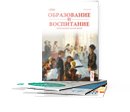The digital revolution has transformed English language teaching, with gamification emerging as a powerful tool for enhancing motivation and proficiency. This study explores the original classification of gamification in ELT and the first applied methodology integrating game mechanics into language learning environments. Drawing on Self-Determination Theory, flow theory, and experiential learning, it examines how game elements such as points, badges, and narrative-driven tasks support learner engagement. The paper highlights the benefits of goal setting, real-time feedback, and social interaction in gamified learning. Practical applications demonstrate increased persistence and improved language skills, while challenges include maintaining intrinsic motivation. Future research should explore AI and VR-enhanced gamification for more immersive learning experiences.
Ключевые слова: gamification, English language teaching, motivation, digital education, game-based learning, language acquisition, learner engagement, self-determination theory, experiential learning.
The digital revolution has reshaped the landscape of education, offering new opportunities to enhance teaching and learning processes. Among the most promising innovations is gamification, which involves the application of game design elements in non-game contexts. In the field of English language teaching, gamification has gained traction as a means to increase learner engagement, motivation, and proficiency. This paper focuses on the original classification of gamification in ELT and the first applied methodology that introduced game mechanics into language learning environments. By exploring its theoretical underpinnings, implementation strategies, and outcomes, this study aims to shed light on how gamification can revolutionize digital education for English language learners [1].
Theoretical Foundations
The integration of gamification into ELT is grounded in several key theoretical frameworks. Self-Determination Theory (SDT), which emphasizes the importance of autonomy, competence, and relatedness in fostering intrinsic motivation, provides a foundation for understanding how gamification enhances learner engagement. Game elements such as points, badges, and leaderboards cater to these psychological needs by providing learners with a sense of achievement, progress, and social interaction [1]. Additionally, the concept of flow, as proposed by Csikszentmihalyi, aligns with gamification by highlighting the importance of balancing challenge and skill to maintain learner interest and focus [2].
Another critical theoretical basis is the concept of experiential learning, which posits that learners acquire knowledge more effectively through active participation and reflection. Gamification creates immersive learning environments where learners can experiment with language in meaningful contexts, receive immediate feedback, and reflect on their progress. This aligns with the principles of task-based language teaching (TBLT), which emphasizes the use of authentic tasks to promote language acquisition. The combination of these theoretical frameworks provides a robust foundation for the integration of gamification into ELT [2].
Original Classification of Gamification in ELT
The original classification of gamification in ELT can be traced to the early applications of game design elements in digital learning platforms. Initially, gamification was conceptualized as a way to make learning more enjoyable and engaging by incorporating elements such as points, levels, and rewards. However, the first applied methodology in this domain focused on creating a seamless integration of game mechanics with pedagogical objectives. This approach was characterized by its emphasis on aligning game elements with learning outcomes, ensuring that gamification enhanced rather than distracted from the educational experience [3].
One of the earliest implementations of this methodology involved the use of digital badges to recognize learner achievements. Badges were awarded for completing specific tasks, such as mastering a set of vocabulary words or achieving a certain level of fluency in speaking exercises. This approach not only motivated learners to complete tasks but also provided a visual representation of their progress, fostering a sense of accomplishment. Another key feature of this methodology was the use of narrative-driven learning, where learners embarked on virtual quests or storylines that required them to use English in context. This immersive approach made language learning more engaging and relevant to real-world scenarios [2–3].
First Applied Methodology
The first applied methodology integrating gamification into ELT focused on three core components: goal setting, feedback mechanisms, and social interaction. Goal setting involved defining clear objectives for learners, such as completing a level or earning a specific badge. These goals were designed to be challenging yet achievable, ensuring that learners remained motivated throughout the learning process. Feedback mechanisms provided learners with real-time information on their performance, allowing them to identify areas for improvement and celebrate their successes. This immediate feedback loop was crucial in maintaining learner engagement and promoting a growth mindset [4].
Social interaction was another key component of this methodology. Gamified platforms often included features such as leaderboards, team challenges, and collaborative tasks, which encouraged learners to interact with their peers. This social dimension not only enhanced motivation but also provided opportunities for authentic language practice. For example, learners might work together to solve a problem or compete in a language-based game, using English to communicate and collaborate. By combining these elements, the first applied methodology created a dynamic and interactive learning environment that catered to the diverse needs of English language learners [4].
Practical Applications and Outcomes
The practical applications of this methodology have demonstrated significant potential for improving motivation and language proficiency. In classroom settings, gamified platforms have been used to supplement traditional instruction, providing learners with additional practice opportunities and personalized feedback. For example, teachers can use gamified quizzes to reinforce vocabulary and grammar concepts, while learners can engage in interactive storytelling activities to develop their speaking and listening skills. In self-directed learning contexts, gamified apps and platforms have enabled learners to study at their own pace, making language learning more accessible and flexible.
Research on the outcomes of this methodology has shown promising results. Studies have reported increases in learner motivation, particularly in terms of persistence and effort. Learners who engaged with gamified platforms were more likely to complete tasks and achieve their learning goals compared to those using traditional methods. Additionally, improvements in language proficiency were observed, particularly in areas such as vocabulary retention, grammar accuracy, and communicative competence. Learners also expressed high levels of satisfaction with gamified learning experiences, citing increased enjoyment and a sense of accomplishment as key benefits [5].
Challenges and Future Directions
Despite its potential, the integration of gamification into ELT is not without challenges. One major concern is the risk of over-reliance on extrinsic rewards, which may undermine intrinsic motivation in the long term. Additionally, the design of gamified platforms must strike a balance between entertainment and educational value, ensuring that game elements enhance rather than detract from learning outcomes. Educators and developers must also consider the diverse needs and preferences of learners, as not all students may respond equally to gamified approaches.
Looking ahead, future research should explore the long-term impact of gamification on language acquisition and learner motivation. There is also a need for further development of gamified platforms to incorporate more advanced technologies, such as artificial intelligence and virtual reality, which could create even more immersive and personalized learning experiences [1–2].
Conclusion The integration of gamification into English language teaching represents a groundbreaking shift in digital education. By focusing on the original classification and first applied methodology, this paper has highlighted the transformative potential of gamification to enhance motivation and language proficiency. As educators and researchers continue to explore and refine these approaches, the future of language education promises to be more engaging, effective, and inclusive than ever before.
References:
- Deterding, S., Dixon, D., Khaled, R., & Nacke, L. (2011). «From game design elements to gamefulness: Defining ‘gamification’». Proceedings of the 15th International Academic MindTrek Conference: Envisioning Future Media Environments, 9–15.
- Gee, J. P. (2007). What Video Games Have to Teach Us About Learning and Literacy. Palgrave Macmillan.
- Kapp, K. M. (2012). The Gamification of Learning and Instruction: Game-Based Methods and Strategies for Training and Education. Pfeiffer.
- Hamari, J., Koivisto, J., & Sarsa, H. (2014). «Does gamification work? A literature review of empirical studies on gamification». 47th Hawaii International Conference on System Sciences (HICSS), 3025–3034.
- Deci, E. L., & Ryan, R. M. (1985). Intrinsic Motivation and Self-Determination in Human Behavior. Springer.







